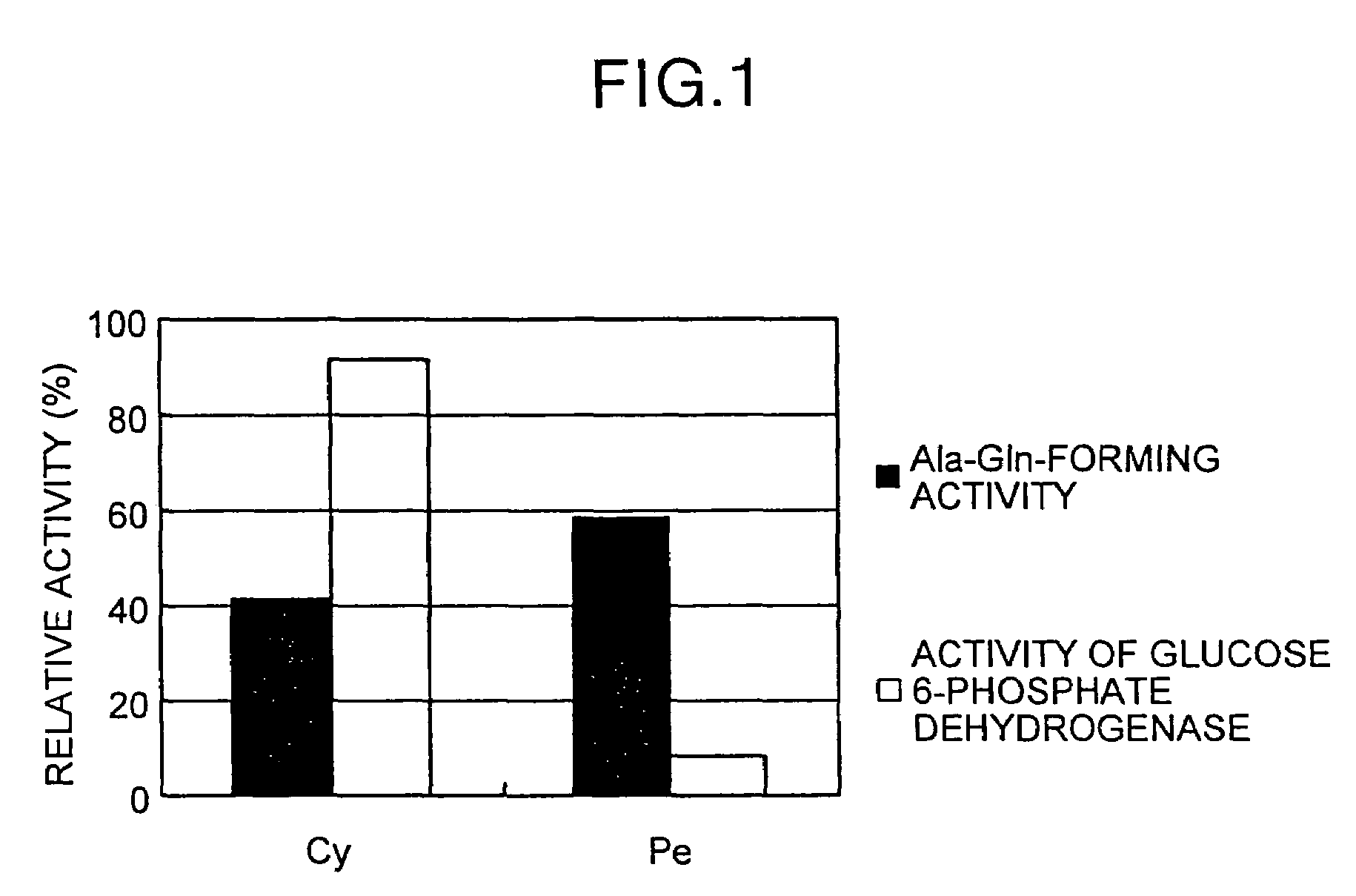Method for producing α-L-aspartyl-L-phenylalanine-β-ester and method for producing α-L-aspartyl-L-phenylalanine-α-methyl ester
a technology of phenylalanine and alpha-methyl ester, which is applied in the field of producing alpha-l-aspartyl-l-phenylalanine-betaester and method for producing alpha-l-aspartyl-l-phenylalanine-alphamethyl ester, can solve the problems of unsuitable industrial production method and troublesome processing, and achieves easy production of -l-aspartyl-l-phenylalanin
- Summary
- Abstract
- Description
- Claims
- Application Information
AI Technical Summary
Benefits of technology
Problems solved by technology
Method used
Image
Examples
example 1
Microbes that Produce α-L-aspartyl-L-phenylalanine-β-methyl ester
[0254]50 milliliters (“mL” or “ml”) of a medium (pH 7.0) containing 20 grams (“g”) of glycerol, 5 g of ammonium sulfate, 1 g of potassium dihydrogen phosphate, 3 g of dipotassium hydrogen phosphate, 0.5 g of magnesium sulfate, 10 g of yeast extract and 10 g of peptone in 1 liter (L) that was transferred to a 500 mL Sakaguchi flask and sterilized at 115° C. for 15 minutes (medium 1) was used to culture bacteria and actinomycetes shown in Table 1-1. A slant agar medium (pH 7.0) containing 5 g / L of glucose, 10 g / L of yeast extract, 10 g / L of peptone, 5 g / L of NaCl and 20 g / L of agar in the medium 1 was prepared and a microbe shown in Table 1 was cultured on this slant agar medium at 30° C. for 24 hours. Then, one loopful of the microbe was cultured in the medium 1 at 30° C. for 24 hours, followed by shake culturing at 30° C. and 120 strokes / min for 17 hours. After completion of the culturing, the microbial cells were sepa...
reference example 1
Microbe that Produces β-L-aspartyl-L-phenyl-alanine-α-methyl ester
[0281]Microbes shown in Table 2 were cultured similarly to the procedure in bacteria in Table 1 of Example 1. After completion of the culturing, the microbial cells were separated from these culture broths by centrifugation, and suspended in 0.1 M borate buffer (pH 9.0) containing 10 mM EDTA to 100 g / L as wet microbial cells. To 0.1 mL each of the microbial cell suspensions of these microbes was added 0.1 mL of 100 mM borate buffer (pH 9.0) containing 10 mM EDTA, 100 mM L-aspartic acid-α,β-dimethyl ester hydrochloride and 200 mM L-phenylalanine to make the total amount 0.2 ml, followed by reaction at 30° C. for 2 hours. The amount (mM) of β-L-aspartyl-L-phenylalanine-α-methyl ester (β-AMP) produced in this case is indicated in Table 2. Note that no α-AMP was detected in all the microbes.
[0282]
TABLE 2Microbeβ-AMP (mM)Hafnia alvei ATCC 97600.30Klebsiella pneumoniae ATCC 83080.26
example 2
Purification of Enzyme from Empedobacter brevis
[0283]A 50 mL medium (pH 6.2) containing 5 grams (g) of glucose, 5 g of ammonium sulfate, 1 g of monopotassium phosphate, 3 g of dipotassium phosphate, 0.5 g of magnesium sulfate, 10 g of yeast extract and 10 g of peptone in 1 liter (L) was transferred to a 500 mL Sakaguchi flask and sterilized at 115° C. for 15 minutes. This medium was then inoculated with 2 milliliters (ml or mL) of Empedobacter brevis strain FERM BP-8113 (Depositary institution: the independent administrative corporation, National Institute of Advanced Industrial Science and Technology, International Patent Organism Depositary, Address of depositary institution: Chuo Dai-6, 1-1 Higashi 1-Chome, Tsukuba-shi, Ibaraki-ken, Japan, International deposit transfer date: Jul. 8, 2002) that had been cultured at 30° C. for 16 hours in the same medium, followed by shake culturing at 30° C. and 120 strokes / min for 16 hours.
[0284]Subsequently, the procedure after centrifugal sep...
PUM
| Property | Measurement | Unit |
|---|---|---|
| temperature | aaaaa | aaaaa |
| pH | aaaaa | aaaaa |
| pH | aaaaa | aaaaa |
Abstract
Description
Claims
Application Information
 Login to View More
Login to View More - R&D
- Intellectual Property
- Life Sciences
- Materials
- Tech Scout
- Unparalleled Data Quality
- Higher Quality Content
- 60% Fewer Hallucinations
Browse by: Latest US Patents, China's latest patents, Technical Efficacy Thesaurus, Application Domain, Technology Topic, Popular Technical Reports.
© 2025 PatSnap. All rights reserved.Legal|Privacy policy|Modern Slavery Act Transparency Statement|Sitemap|About US| Contact US: help@patsnap.com


